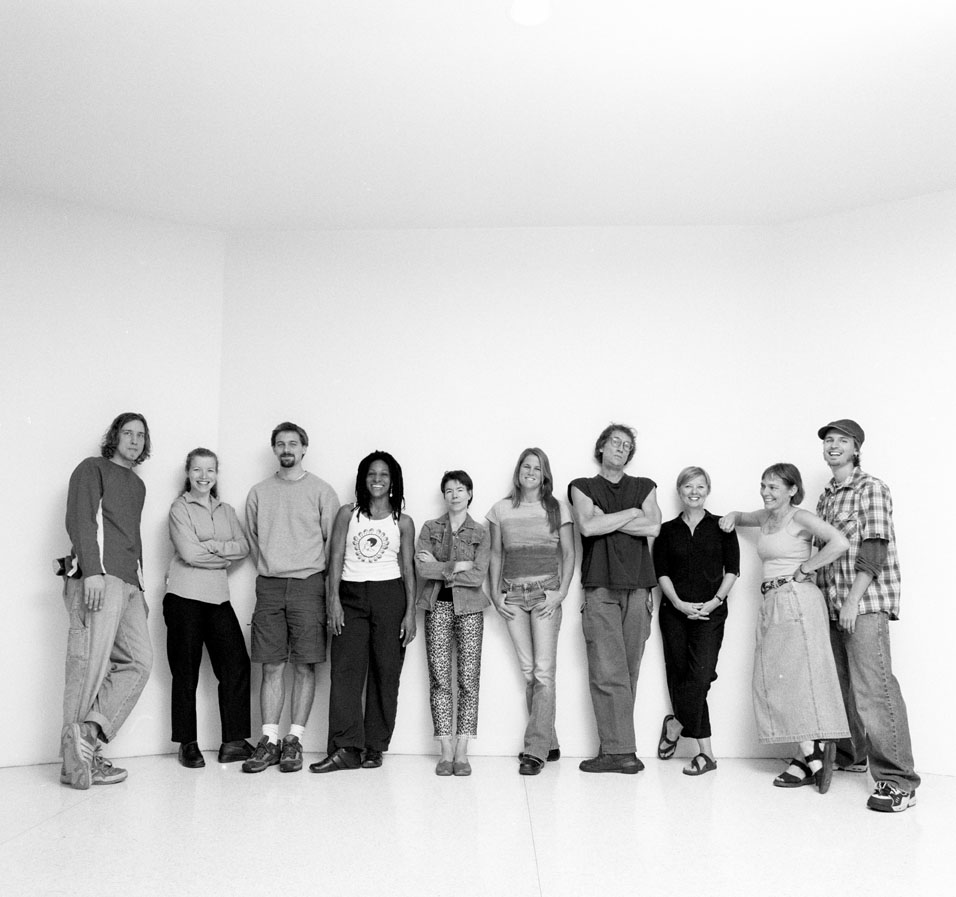Dance Review: Choreographers Evening 2003
Dancers in dialogue was the order of the night during the 32nd Annual Choreographers Evening at the Walker Art Center on Saturday, November 29.

Colin Rusch loves donuts. He is upfront about this little tidbit of information, and it means more than you may think. Take his approach to curating the 32nd Annual Choreographer’s Evening at the Walker; donuts were integral to his thought process for this event. He notes in the program that he always asks, “What is significant, if anything, about my dance work to the people who sell me donuts?” The choreographer’s evening was an opportunity to ask such questions on a large scale, and Rusch used this to create conversations–between art and community, between art and audiences, and between art and art.
Rusch chose the ten pieces presented, out of fifty auditioned, because they spoke to one another on some level: “I had two criteria for choosing work. The first was to find work that felt alive to me. The second criterion was to look for the conversations happening among the works.” The ten pieces were separated out into five pairs, in each of which Rusch could see a dialogue going on. Rusch undoubtedly had his own conversations in mind, but here’s what I heard:
The first pair, “Too!” by Laurie Van Weiran and an excerpt from “Trappings” by Penelope Freeh, seemed to not have much to talk about. The first was overly cartoony, with exaggerated hoop skirts and plasticky blond wigs. The second was quite subdued and somberly striking, beginning with merely feet peeking out from the black curtains, and the subtlest hint of bodies behind. Looking deeper, the not-quite-human movements of the pieces did seem to find some common ground. Van Weiran’s dancers wobble and jerk as if they’re held up by marionette strings. Freeh’s movements are much more fluid, but still retain a doll-like quality.
The second pair spoke to me of courtship. In “Charms and Challenges” by
Jane Peck and Elizabeth Aldrich, this took the form of a demure eighteenth-century waltz and a playful jig of the same period, with a few modern twists. “Peacock Feathers” by Jesse Walker and Amber Ellison was reminiscent of modern playground romance. Sticks are integral to the piece, used to play roles from ninja to drum majorette. The titles of both pieces could apply to either, as the courtship process is all about impressing, charming, and challenging, and both pieces play with each of these conventions.
“Uncertain Lines” by Meg Elias-Emery and an excerpt from “Evolution of a
Soul Sister” by Roxanne Wallace added an urban conversation to the mix. The aerial artistry in Elias-Emery’s piece brings a feeling of flying across city rooftops to the sound of street-corner jazz and poetry. Wallace showcases eight dancers in a piece that called up the most kinesthetic response from me. Utilizing a fusion of jazz, hip-hop, modern, Caribbean, and West African styles, with a few boxing moves thrown in for good measure, this piece spoke to me of how these things come together in the urban landscape and create something new and different and alive, from rooftop carnivals to dancing in the streets.
The fourth pair did its best to stretch the definitions of “dance,” with a pointed lack of movement in the first piece and the absence of any
three-dimensional dancers in the second. Michael Yonkers, who dances with the Hauser Dance Company and the Continental Ballet Company, presented a feedback-and-noise-heavy guitar solo in “Call Me, But Don’t Call Back.” Otto Ramstead and Olive Beiringa, together known as the BodyCartography Project, danced on film instead of stage. Rusch explained to the audience, “well, they’re in Brazil.” Although the audience seemed a bit confused in their applause for these pieces, this was a brilliant move on the part of Rusch and the artists. Want to create a dialogue about dance? Throw something like this into a dance show and you’ll have people asking one of the biggest questions
in the genre (“What is dance?”) without much coaxing.
The fifth pair ushered out the show with strong percussive footwork.
Colette Illarde and TF5 (Ten Foot Five) presented pieces that were dialogues of the feet. In Colette Illarde’s stunning flamenco piece, “Ida Y Vuelta (Journey and Return),” her feet engaged in a heated discussion with the audience. This discussion was punctuated by those facial expressions that are characteristic of the form, from the surprised-looking ones that say, “Oh, look, are those really my feet doing all that?,” to the dramatic furrowed-brow ones that say, “It pains me how incredible these feet can be.” In TF5’s “Britney Tongued Madonna,” by far the longest and loudest piece, five young tap masters had a footy dialogue with the audience and with each other. Their piece reminded me of all those great breakdance battles of the ‘80s: A war with no contact, and all style.
Of course I’m working within Rusch’s five-pair framework here, but I can see conversations between other pieces too. Freeh’s and Elias-Emery’s could have a nice chat about surrealism. Wallace’s and TF5’s could get together and jam. The possible conversations are endless. The tradition of the Choreographer’s Evening is to bring together a sampling of what’s going on in the local dance community. And as in any good rap song, those samples are brought together from different artists and forms and juxtaposed in such a way as to make you hear, see, feel something new; to listen to the conversations within the work and to create ones outside of it. Just call him Mixmaster Rusch. Based on his compilation technique and entertaining MC-ing throughout the performance, he should wear the title proudly.